
38 minute read
Departure of the Late Nineteenth Century Cattle Companies from Southeastern Utah: A Reassessment
Departure of the Late Nineteenth Century Cattle Companies from Southeastern Utah: A Reassessment
By CLYDE L. DENIS
Aflamboyant and unique period of southeastern Utah history involved the sudden arrival of large cattle companies in the early 1880s to reap the financial benefits proffered by free, open, and productive range land. Estimates have been made that well over a hundred thousand cattle used the areas around the Blue (Abajo) and La Sal Mountains, most owned by the large companies. It was a time replete with inevitable range conflicts, cattle fiefdoms against intrepid Mormon settlers, Indian depredations, and drunken cowboy rampages. And, then, just as suddenly, by the mid-1890s the large cattle companies were gone. While other local companies changed hands, departed, and even prospered over the next decades, the apparent rise and fall of these gargantuan cattle companies created an enduring legend of great interest.
Several historians and writers over the recent decades have suggested at least ten causes for the departure from southeast Utah of three large cattle companies: drought, overgrazing and decimation of the range, a severe decline in cattle prices, San Juan County taxes, cattle rustling, Mormon resistance to cattle company expansion, hostile Indians, sheep competition, the Panic of 1893, and the European depression of 1890.1

Cowboys herding cattle.
UTAH STATE HISTORICAL SOCIETY
However, it has been at least a quarter century since the last serious analysis of these issues was conducted. Because accurate information is now available indicating when the cattle companies departed, the timing and duration of the late nineteenth-century drought, and the dates when the Mormon conflicts with the cattle companies were resolved it is time to reassess the principal causes for the cattle company departures. This new information is critical in that a careful analysis of what caused the large cattle companies to depart must be constrained by the actual timeline of their departures. Such an analysis indicates that the two primary causes for the large reduction in cattle numbers across all of southeast Utah at the turn of the century were a severe and longstanding decline in cattle prices nationally, and the excessive overstocking and overgrazing of the range.
This article will introduce the three major cattle companies and smaller livestock operators in southeastern Utah during the late nineteenth century and then analyze the merits of each of the reasons offered for the departure of the large cattle companies. In addition, the cattle company departures will be viewed within the larger trends of the western range. The flourishing of the cattle industry in southeast Utah was a late event in the livestock history of the West, coming at the end of a spectacular boom in the western cattle industry. The industry bust after 1885 contributed to and presaged its similar end in southeast Utah. A re-evaluation of this critical historic period introducing new information as to exactly when the cattle companies departed will clarify these issues and determine whether the large cattle companies really “fell,” as in some type of failure that was unique to them.
The three largest cattle companies of southeastern Utah after 1880 were the Kansas and New Mexico Land and Cattle Company, commonly referred to as the Carlisle Cattle Company, the Lacy-Coleman (LC) Cattle Company, and the Pittsburgh Land and Cattle Company. Other smaller outfits existed at the same time, such as the Mormon Bluff Pool with several thousand head, the Elk Mountain Cattle Company which had around two thousand head, and Turner and Holman with about thirty-four hundred head. 2 However, these smaller cattle outfits did not succeed to the size and power the big three enjoyed. The LC Cattle Company had its main headquarters near the Dolores River in Lewis, Colorado; the Carlisle Cattle Company was in Carlisle, located six miles north of Monticello, and the Pittsburgh Cattle Company was located at La Sal.
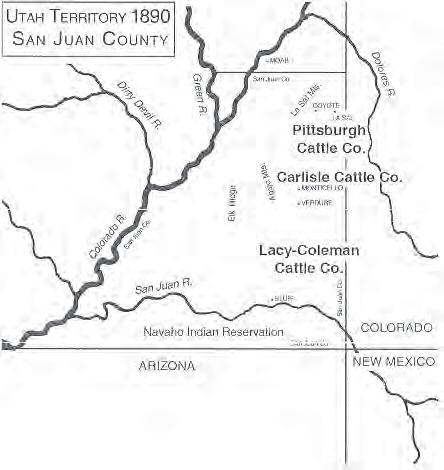
Utah Territory 1890 map of Cattle Companies in Southeastern Utah.
The large number of cattle that were run by the big three cattle companies was impressive. Carlisle Cattle Company at its departure sold thirty thousand cattle, LC Cattle Company sold approximately twenty-two thousand cows, and the Pittsburgh Cattle Company released ten to fifteen thousand. The number of cattle in San Juan County at that time was estimated as at least a hundred thousand cattle.3 These numbers are staggering considering that the famous Scorup-Sommerville Cattle Company of the early to middle twentieth century typically only ran seven to twelve thousand cattle.4 These numbers indicate that the cattle industry of the last twenty years of the nineteenth century was much more extensive than in subsequent years, as the total number of cattle run by large and small ranchers diminished significantly at the end of the nineteenth century.
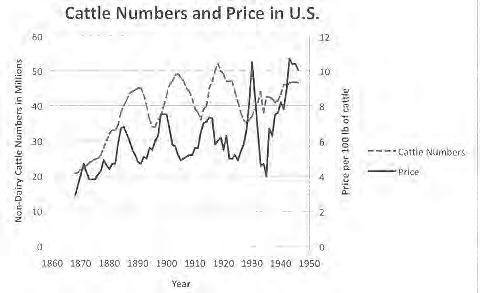
Cattle Numbers and Prices in dollars.
After 1885, the range cattle industry suffered a glut of cattle and overstocking, resulting in decreased prices and huge declines in cattle numbers.5 For example, from 1885 to 1895 Colorado and Wyoming saw the number of cattle reduced by 25 percent. From 1890 to 1895, southeast Utah ranchers similarly reduced their cattle numbers. The reason the decline in the number of cattle in San Juan County began at a later date is that cattle operations were delayed entering into southeast Utah until after the Native American population was subdued in the early1880s.
The beginning point in any analysis is establishing when the large cattle companies exited the region. The Pittsburgh Cattle Company, which bought out several small herds in the La Sal Mountains in 1886, was the last of the three companies to actually dissolve. This company was most typical of the absentee landlordism that was synonymous with cattle barons buying into the western range. Individuals from Pittsburgh held the $210,000 in shares in the company. In 1888, the Pittsburgh Cattle Company, unable to achieve its expected profits, replaced their manager and foreman with John Mendell Cunningham and Thomas B. Carpenter. Carpenter was the nephew of one of the Pittsburgh Cattle Company investors and may have worked for the company in South Dakota and Wyoming. He was a tall reserved man who like to operate by a time table, rewarding efficiency in both his men and horses. Cunningham was from De Soto, Missouri. Although locally renowned as “the milk man of De Soto,” he was recommended to the company by his uncle from Blairsville, Pennsylvania, where a number of Pittsburgh Cattle Company investors lived.7 Cunningham, in the early 1900s, was described as a man with “the inevitable cigar sticking out from his stubby gray mustache.” He was “stocky, kindly, slow of speech, he was square and just and beloved by all who came in contact with him.”8
In the 1890s when four thousand calves were branded, the Pittsburgh Cattle Company herd was estimated at ten to twelve thousand cattle—a conservative figure based on documentation that for cattle on the public domain in Utah, the ratio of total herd size to calves branded was four to one.9
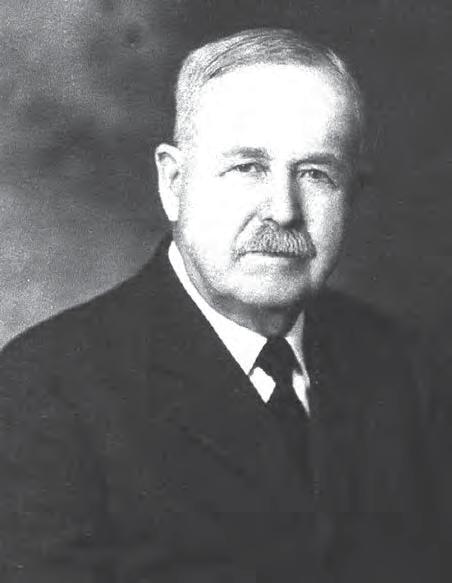
John M. Cunningham.
PHOTO COURTESY OF BILL AND JOYCE CUNNINGHAM
While the owners of the Pittsburgh Cattle Company were far removed from southeast Utah, they were keen to resist threats to their investment. One such threat came from the citizens of Colorado who wanted the federal government to remove the Ute Indians from southwestern Colorado to an Indian reservation in southeastern Utah. Individual investors in the Pittsburgh Cattle Company used its presence in the East to advantage to lobby the federal government to maintain free and open lands in southeast Utah for the livestock industry. In contrast, in 1888 Monticello community leader Francis A. Hammond commented that the Mormons would only be to “some extent” affected by the move of the Indians and that “None of us, however, have any title to these lands.”10 Two years later, Hammond said, “the residents of San Juan County are by no means disheartened at the prospect of having their lands set apart by the government as an Indian Reservation.”11
The agent of the Indian Tribal Authority, a group of well-connected Protestant Indian reformers in Washington, D.C., opposed to the Ute relocation, was criticized by Senator E.O. Wolcott of Colorado as being in cahoots with the Pittsburgh Cattle Company, “lobbying in an unholy cause,” is how he phrased it.12 Another Indian Tribal Authority agent also opposed the relocation for several reasons, foremost because “it would remove them [the Utes] from civilized surroundings,” interesting comments about the then-current state of San Juan County.13 In 1889, Pittsburgh Congressman John Dalzell supposedly persuaded one of the committee members reviewing the bill to delay its passage “by [putting] it in his pocket.”14 As summed up in 1893, “the Pittsburgh Cattle company have [sic] been the chief opponent of the proposed removal, which perhaps is correct, they having been able to do more than people of less means.”15 A year later, in the winter of 1894-95, the Pittsburgh Cattle Company sent Cunningham to Salt Lake City to persuade Governor James West that San Juan County should not be abandoned to the Utes.
The Pittsburgh Cattle Company departure from southeast Utah probably occurred in the late fall of 1896.16 In 1915, C.A. Robertson, a prominent Moab lawyer and newspaper editor, in an article on Monticello and Moab, also gave 1896 or 1897 as the year that the Pittsburgh Cattle Company sold out to Cunningham, Carpenter, and Fred N. Prewer.17 Moreover, it was reported in June of 1896 that “Fred Prewer for the Pittsburgh Cattle Co….is working to secure a postoffice at Coyote,” near their La Sal headquarters and in October of that year that Prewer of the Pittsburgh Cattle Company was granted the right for the post office. 18 Since the company changed its name after the sale to the La Sal Cattle Company, the end of the Pittsburgh Cattle Company must have occurred soon after October 1896.
Importantly, when the owners of the Pittsburgh Cattle Company sold out, the new owners, Cunningham and Carpenter, diversified their operation to include sheep and reduced the number of cattle grazing on the same open range land. When Cunningham left the area at age fifty-nine, the J.M. Cunningham Company was renowned for its success and was used as the exemplar of the local stock industry: “And some wonderful successes have been made in this line. Eighteen years ago two men bought on credit for
$75,000 what was thereafter known as the J.M. Cunningham & Company ranch and live stock property and ranch at La Sal. The value of the property today, and the money that has been taken out of it, amounts to something over a half milliondollars.”19 Cunningham and Carpenter, in addition to having the premier ranch in the area, were also recognized for their exceptional integrity. Years later in 1910, a young man reported, “Many times we got word of our cattle that were a long way from home but we never got very many of them back….When Cunningham and Carpenter owned the Cross H cattle, they helped us by gathering our cattle with their own. After the cattle were gathered they would ship and sell them for us.”20 Investors from around the country came to discuss terms with Cunningham and Carpenter when they put their Utah investments up for sale.21 After selling out to local interests in Utah, Cunningham retired near Denver, Carpenter to Fort Collins.22
The LC Cattle Company displayed a typical pattern for the decline of a large cattle company in San Juan County. Formed by the merging of herds and interests of Isaac W. Lacy with L. G. Coleman in Texas in 1870, the LC Cattle Company entered the Montezuma County area of southwestern Colorado in 1879 with about five thousand head of cattle.23 In the next year they spread westward, establishing their Utah ranch headquarters at the junction of Johnson and Recapture Creeks north of the San Juan River and Bluff. Of the three major cattle companies under discussion, the LC Cattle Company was the only cattle outfit owned by cattlemen from the southwest.
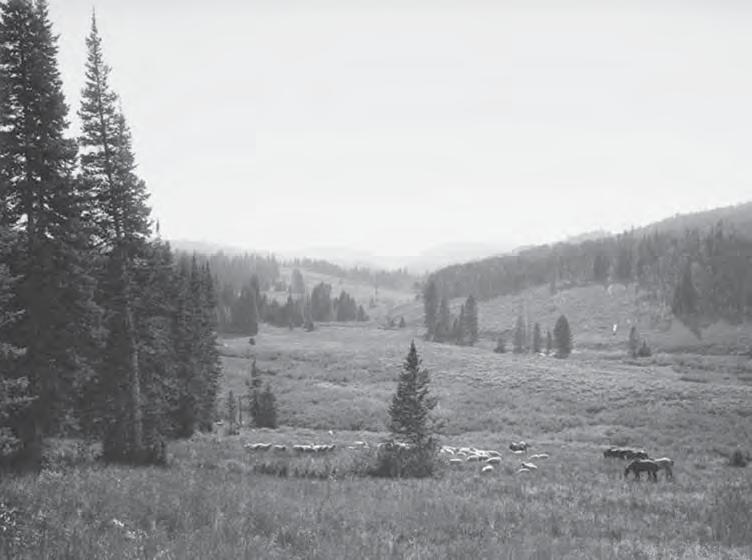
UTAH STATE HISTORICAL SOCIETY
The LC Cattle Company over the next decade became very productive, but by the years of 1892 and 1893 it sold its twenty-two thousand cattle at eleven dollars a head at Dolores, Colorado. At the same time, the company closed its line camp at Verdure and sold its Recapture headquarters and the LC brand to Dr. W. I. South. It was also about this time that Scott and Campbell obtained the LC Cattle Company’s range rights southeast of Monticello and Montezuma Canyon to Monument Creek.24
The founders of the LC Cattle Company did not disappear completely, however. Sarah Lacy, the widow of Isaac Lacy who had been murdered in 1881, was aided in running the cattle company by her two brothers, William and John Brumley. The two brothers continued to operate their own spread in southwest Colorado; having started at Brumley Draw near Lewis, they eventually migrated down to Big Bend near present day Dolores. The Brumleys were involved in the political life of the community and broadened their business interests by opening a fine saloon in Dolores in 1896 that later became a nationally recognized hotel. They maintained their cattle outfits in the area after the demise of the LC Cattle Company and left several generations of Brumleys in their wake.25
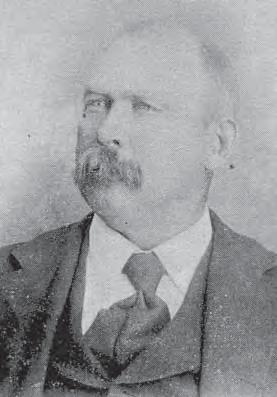
William Brumley.
PHOTO COURTESY OF RICHARD H. DALRYMPLE
The final large cattle company, the Kansas and New Mexico Land and Cattle Company, was run by two English brothers, Edmund and Harold Carlisle, born in the early 1850s. Unlike the Pittsburgh Cattle Company absentee owners, the Carlisle brothers were intimately involved in their company and lived in southern Utah. Harold Carlisle following the sale of their cattle in the early 1890s for a time stayed in the livestock business in Utah. Eventually, Harold Carlisle left Utah for good in 1911, selling out to Mormon interests.
While a photograph of Harold Carlisle has yet to be found, a contemporary of Harold described him as:
The brothers also owned a thousand acres in Kansas and operated a large spread in Gallegos Canyon in New Mexico. But it was in San Juan County where their main livestock operation of twenty- to twenty-five thousand head was located with a smaller cattle operation of only three to four thousand in New Mexico. Beginning in 1883, the Carlisles bought up several local herds and had about seven thousand head. The following year they had at least ten thousand head of livestock.27
From their ranch headquarters at Carlisle, north of Monticello, the Carlisles in their heyday ran an enormous enterprise with at least eightyfive riders.28 The size of the Carlisle herds in the mid-1880s can be fairly well estimated, based on a report that fifty-three hundred calves were branded in 1885, indicating an approximate total of twenty-one thousand cattle.29 After selling most of his cattle, Harold Carlisle remained in the livestock business expanding to raising sheep. By about 1898, he had some six thousand head of sheep, and from 1893 to 1898 he used his ranch at Carlisle in partnership with his son-in-law W.E. (Latigo) Gordon, the infamous foreman of the Carlisle Cattle Company and known for his wildness, abundance of bullet wounds, drunken escapades and brushes with the law, to raise hay for young cows that were then shipped to Kansas. Harold Carlisle meanwhile opened a gents furnishing store in Kansas City.30
The Carlisle Cattle Company, like the LC Cattle Company, ceased cattle operations in southeastern Utah in 1893. While Frank Silvey, an early settler and record keeper in southeastern Utah, remembers that the Carlisles sold their cattle over a period of four years beginning in 1891 or 1892, they abandoned their New Mexico ranch and headquarters in 1893, shipping 3,300 head of cattle to Kansas in late November of 1893.31 In 1894, the Mancos Times reported that “Harold Carlisle has sold the remnant of the once immense Carlisle herd of cattle….to Jud. Pierce of Disappointment.” 32 In an 1898 Federal Court of Appeals decision in a libel case involving Harold Carlisle, the court records confirmed 1893 when the Kansas and New Mexico Land and Cattle Company sold its livestock.33
What is salient in the above descriptions of the big three cattle companies is the decline in the immense numbers of cattle owned by these outfits in southeast Utah in the early to middle 1890s. Yet, the three companies did not uniformly decline. The Pittsburgh Cattle Company changed hands, added sheep and became very successful. The Carlisle Cattle Company changed emphasis, first to fattening young cows, then successfully raising sheep. The LC Cattle Company retreated to its headquarters in Colorado where it continued to raise cattle there, albeit on a much reduced scale.

Cattle moving along a Utah mountain trail.
UTAH STATE HISTORICAL SOCIETY
Similar changes occurred during this period for other smaller companies. The Mormon Bluff Pool Cattle Company disbanded in 1898, selling its herds to various small owners. The Bluff Pool would have failed much earlier if it had not been for J.A. Scorup’s tenacity and skill. The Elk Mountain Cattle Company, which moved into the area south and west of the Elk Ridge in late 1887, tried to compete with the Bluff Pool but failed completely, and sold out to the Bluff Pool five years later.34
But what were the causes of the large cattle company departures? Unfortunately, just at the opening of the range in southeast Utah, the western cattle industry underwent a dramatic bubble of speculation and increase. Following the depression of the early 1870s and a febrile economic climate, a huge section of the western range had become available. Factors that contributed to this were the expansion of railroads (the railroad reached Durango, Colorado, in 1881) and the removal of the Indian threat to vast tracts of land in Montana, Wyoming, Colorado, and Utah. Texas was unable to supply the burgeoning demand for cattle, driving up meat prices across the United States. The availability of apparently unrestricted free grasslands in these states seemed to augur unlimited profits for cattle companies. By 1883, cattle companies from Texas to Montana were described as reeling in 25 to 40 percent profits per annum. The price of beef sold in the Chicago Stock Yards correspondingly increased, enhancing the boom.35 During the decade following the 1870s depression, the states of New Mexico, Colorado, Wyoming, and Montana experienced a five-fold increase in cattle from five hundred thousand.36 With glowing reports of profits in newspapers and books, British and Scottish investors, as well as those from the eastern United States, jumped into the cattle business. Historian Dale described it as,
But by 1884 the peak of this western cattle boom had occurred. A recessionfrom 1884 to 1886 caused a dip in prices and less meat was consumed as wages declined. British importation of cattle also dropped in these years, as fears rose over importing diseased cattle. Texas cattlemen, unable to sell their cattle in England because of a pleuro-pneumonia outbreak, began to dump more on the United States market. This was coupled with a severe winter in 1884-85 on the southern Great Plains that caused the release of more cattle onto the market as cattle companies folded. The removal of two hundred thousand cattle from the Arapahoe-Cheyenne reservations into Colorado and the Great Plains by President Cleveland’s proclamation in late 1885 exacerbated this glut of livestock and decline in prices.38 As one writer commented at the time: “But profit and loss can no longer control it. The cattle are there; they are increasing by thousands daily; the pasture they have taken possession of is no longer able to carry them all, and for self-preservation the overgrown herds must be depleted.” Or as summed up by another more recent commentator, “Even if it proved desirable, enterprising ranchers could not create more land or produce more grass.”39
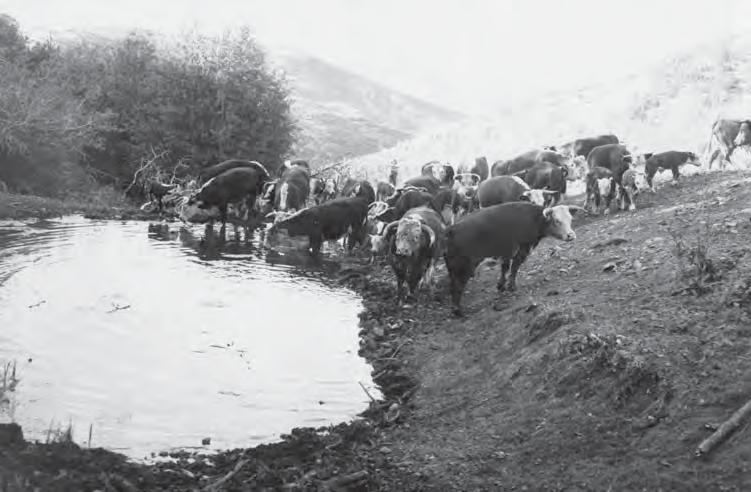
Cattle at a watering hole.
UTAH STATE HISTORICAL SOCIETY
The most dramatic precipitating event that drove down the price of cattle was the severe blizzards of 1886-87 decimating herds throughout the Great Plains, Wyoming, Montana, and Colorado. According to one observer “… it was possible to walk from Greeley to Julesburg [Colorado] on the north bank of the Platte and never set foot on the ground, simply by stepping from one animal carcass to another.”40 Montana and Wyoming suffered a 30 to 40 percent decline in the number of cattle in 1887, which resulted in the failure of many cattle companies. Consequently, Texas livestock men were unable to sell their excess cattle to ranches in the northern states, resulting in a significant drop in the price of cattle in other markets. A typical comment on one sale of cattle in Colorado in 1893 was: “Like all the cattle on sale last week Mr. Jewell’s shipment brought just about enough to make it questionable whether it would not have paid better to have skinned the animals and shipped the hides.”41
Because beef price declines have led directly to the cattle reductions across the United States, the number of cattle in southeast Utah would have declined after 1890 based solely on the decline of prices, irrespective of all other factors. The economic impact on the big three cattle companies in southeastern Utah was noted in the case of the Pittsburgh Cattle Company in which it gave up “because of extremely low prices received for cattle.”42
In addition to these events that faced western livestock men, was the implacable economic decline of the Panic of 1893 which depressed cattle prices further, closed businesses across the country, and resulted in 20 percent unemployment. However, the timing of this severe business downturn occurred after both the LC and Carlisle Cattle Companies had sold most of their cattle. Similarly, the 1890 depression in Great Britain apparently affected neither the LC nor the Pittsburgh Cattle Company.
Other causes have been suggested for the reduction in cattle numbers by large cattle companies in San Juan County. These include an increase in the number of sheep competing for open ranges, San Juan County tax rates, Indian problems, and cattle rustling. However, sheep competition and tax rates had little impact. It has been reported that only eighteen to twentyfive thousand sheep were in southeast Utah in the early 1890s.43 Since the range can sustain about five sheep for every cow, these numbers would have had little effect on the sixty-five thousand or so cattle being run by the three large cattle companies. The role of taxes also appears minimal, since cattle were generally only assessed at one quarter the number being grazed in the county. Scorup recalled that at the time the big stock companies didn’t pay any taxes.44 Indian problems and cattle rustling were endemic to the cattle business in San Juan County, but there is no historical evidence to suggest these problems drove the big cattle companies out of San Juan County in the early 1890s. The cattle companies probably viewed them as irritants that must be endured.
It has also been suggested that San Juan County Mormons were successful both in controlling land use and in obtaining water rights thereby restricting the Carlisle Cattle Company access to range lands and much needed water. Several facts, however, make this a less than compelling argument for the Carlisle Company to withdraw from the county. The major fight between the Mormons of Monticello and the Carlisle Cattle Company over water rights to North Fork of the North Montezuma Creek commenced in 1888, and was later settled in the courts. North Fork was an important source of culinary and irrigation water for the community of Monticello as well as for the Carlisle Cattle Company. The cattle company retained water rights to the North Brook until 1897, long after the cattle were sold.45 During the1890s, when the water remained under the control of the
Carlisle Cattle Company, Monticello residents continually sought some type of agreement as they complained constantly and bitterly about their horrible water situation: “The water got so low that they could hardly get a drink. The little that did come was almost green;” and “In the late summer the creek water became so foul and green that all household water had to be hauled from Soldier Spring in kegs and barrels.”46 Water rights and water use were not issues between the Pittsburgh Cattle Company and the Mormon community as Pittsburgh’s cattle range did not overlap that of the Mormons. In addition, the Mormon controlled Bluff Pool owned limited numbers of cattle that were grazed on Elk Ridge, an area not part of the Carlisle Cattle Company’s grazing grounds. This difference in grazing grounds and the low numbers of cattle owned by the Bluff Pool would not have caused the Carlisle Cattle Company to sell its thirty-thousand head of cattle. There is no historical evidence that the Carlisle outfit and the Mormon use of land were factors which may have caused the cattle company to leave the county. Further, a large number of settlers did not take up significant areas of the land until the 1910s.47
Two other causes for the big cattle companies to withdraw from southeastern Utah are the environmental factors of drought and overgrazing. Several writers have indicated that the beginning of the drought that was experienced in southeastern Utah in the last quarter of the nineteenth century ranged from 1886 to 1893. In contrast, according to a meteorological study of drought in the American Southwest, the eleven years from 1893 to 1904 were defined as severe drought years.48 Additional studies confirm that several years immediately prior to those eleven years southeastern Utah received normal precipitation levels and that the 1893 to 1904 drought was followed by very wet years up to the early 1930s.49 In support of these studies Scorup indicated that 1891 and 1892 were very good for the cattle industry but the next seven years were bad.50 Rains and snows were reported for the winter of 1888/1889 and the year of 1889 in Monticello and nearby Bluff. Also, a study of inscription writing in Canyonlands National Park in relation to winter grazing of cattle has concluded that the winters of 1886-87, 1888-89, and 1891-92 had significant snows in that region.51
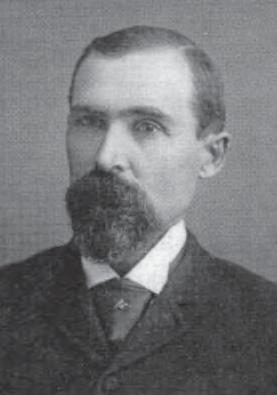
John Brumley.
PHOTO COURTESY OF RICHARD H. DALRYMPLE
Yet, the timing of the 1893 to 1904 drought does not coincide with the movement of cattle out of the region by either the Carlisle or LC Cattle Company, which began about 1891 and was complete by 1893. Only the Pittsburgh Cattle Company, which sold out later, would have been affected by drought.
In contrast to drought, the depletion of the range by overgrazing contributed to the reduction of cattle on the San Juan County range. Later studies of range lands in the 1930s suggest that overgrazing of the salt-desert shrub lands of southeast Utah led to “vast areas of the palatable and nutritious winterfat …. [being] replaced by shadscale and little rabbitbrush.” Shadscale and rabbitbrush were considered worthless. Heavily grazed lands had three- to six-fold more of the worthless species than remnants of the virgin range. Southeast Utah grazing range on average was considered greater than 75 percent depleted for forage by the 1930s compared to 20 to 50 percent in the Great Plains as well as much of Wyoming and Colorado. 52 Seventy percent depletion of the range corresponds to more than a three-fold increase in acreage to support a similar number of grazing animals as compared to the virgin grasslands. The extreme depletion of the southeast Utah range described in the 1936 Western Range Letter was observed at a time immediately following thirty years of what were the highest levels of precipitation that southeast Utah received since the early 1600s.53 Therefore, degradation of the rangeland could not be attributed to drought. Extensive overgrazing of these lands would have resulted in at least a three-fold reduction in the number of grazing animals following depletion of the range in the 1880s.
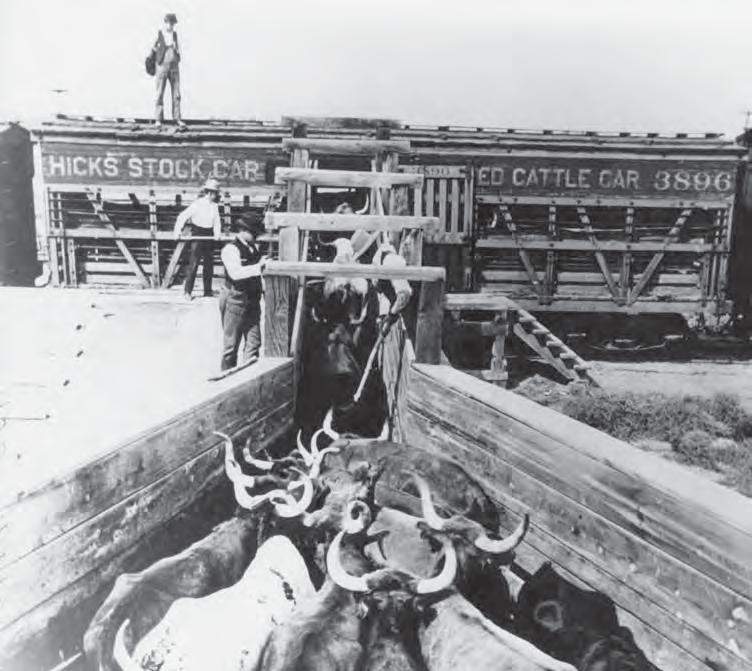
Cattle being loaded into railroad boxcars.
UTAH STATE HISTORICAL SOCIETY
But how much of this overgrazing occurred prior to the early 1890s? The range land of southeast Utah was initially impressive when the first settlers and cattlemen arrived. For example, at Dodge Point just south of Monticello, it was stated that the grass grew “high enough to hide a saddle horse if his head was down feeding.”54 At Elk Mountain, Kumen Jones, the local school superintendent and road supervisor, reported, “There was lots of feed on the mountain in those days [mid-1880s]. The top of the ridge was all grass. There was no sagebrush.” Silvey concurs that when he first came in the mid-1880s to La Sal “the country was a wave of grass.” Early settler A.N. Ray remembered at Coyote (later renamed La Sal), “The cattle we brought with us from …. [Wayne County] were very thin when we got to La Sal, by the first of March they were fat…. The grass in many places in the spring looked like a meadow.” 55 Years later, J.W. Humphrey commented about the range in 1913 when he was the La Sal Forest Supervisor, “For the South Division [i.e., Monticello Forest reserve] there was a little good country [near Indian Creek] to the north and west of Monticello” and “aside from that I do not remember any range on the south division where you could turn out a horse to graze other than in the ranger station pasture or enclosures maintained by the cattlemen for their horses.” In regard to the North Division, Humphrey indicated it “was all overgrazed” with “ranges” that “did not appear to have any forage on them other than the browse that was closely cropped.” Later in the same report it was summarized that pioneer “Stockmen … found here some of the best grazing they had ever seen. The sad part of it is that the ranges were seriously over-stocked from the very first that even as early as 1900….the ranges had deteriorated and erosion was becoming common.” 56 Silvey remembered that before 1894 the ranges were already overstocked. 57 Willard Butts, county sheriff, said in 1894 that the range was “not sufficient for the stock of the [Monticello] settlers.”58 Even by 1888, it was reported that “the San Juan River country….is getting so many cattle that serious fears are expressed of short picking for them.”59 As summarized in 1927, “Between 1885 and 1890 all the Utah ranges were fully occupied.”60
Within a decade following the settlement of Great Salt Lake City and for the next two decades the Mormon dominated territorial legislature passed laws restricting the use of land as well as controlling livestock grazing. This body of land laws restricting livestock grazing was repealed with the passage of the Animals-at-Large Act of 1874. For the next dozen or more years, Utah territorial governors complained to federal officials about the lack of control of public grazing lands. In 1890 Utah Territorial Governor Arthur L. Thomas, for example, called the grazing conditions in the territory “unsatisfactory” and said that “the result is that the man who to-day may find a place where he can feed and water his animals, may tomorrow find himself surrounded by other men with their animals, and in a short time the forage plants sufficient to maintain a limited number of animals are eaten out, or completely destroyed.”61 The results from this lack of control of open range in southeastern Utah and elsewhere in the territory was overgrazed lands. The problem of overgrazing is that usually within ten to fifteen years the loss of plant cover results in severe land erosion when the intense rains of summer hit the now barren land. In fact, devastating floods became common in southeast Utah by the 1890s.62 Local rancher Scorup recalled the rapidity by which overgrazing had led to erosion in Dark Canyon within ten short years after the outfit of Cooper and Martin first came into the area in 1894.63
The overstocking of the range is illustrated in the Elk Ridge area, the last virgin region to be grazed in southeast Utah. The Elk Mountain Cattle
Company entered the area in 1887 even though the Bluff Pool had established cow custom grazing rights to Elk Ridge a year earlier. Yet in 1893, after the Elk Mountain Cattle Company failed to make a go of it, another Texas outfit moved thirteen hundred more cattle into the area. Typical of the state of grazing conditions was that of Bluff Mormon Platte D. Lyman who described his range as “the abomination of desolation…of moving cattle…a time of passing through hades, demanding heavy [toll] of starving live stock [sic] and famishing worn out humanity.”64
This pattern of overgrazing was endemic to the whole west. Referring to the overgrazing conditions in Texas but equally appropriate for the grazing conditions of southeastern Utah was the report that “no small part of the cattlemen’s trouble was due to the reckless policy of overstocking the range.”65 Put yet another way, “A barren pasture will not produce beef any more than the ancient Hebrew could produce bricks without straw. The cattle men became their own most dangerous enemy by their practice of over stocking.”66

If the three large cattle companies left because of overgrazing and low prices, why did they not return to San Juan County when cattle prices later climbed to mid-1880s levels? Drought ended in 1904, followed by nearly thirty years of above average rains. The answer is that the once abundant free grasslands of southeast Utah were no longer there, and what remained would never again sustain the unreasonable stratospheric levels of cattle of the 1880s. The Forest Service, beginning in the early 1900s, made concerted efforts to restrict cattle and sheep permits so that the lands of the La Sal Mountains and Abajos would heal. Over time the livestock industry improved its methods, switching from the open range to raising hay for winter needs and by diversifying into sheep. Sheep provided two cash products, wool and meat, that could sustain the business in uncertain economic times.

A cattle ranch located between Bluff and Mexican Hat in San Juan County.
UTAH STATE HISTORICAL SOCIETY
The departure of the three large cattle companies from southeast Utah cannot therefore be construed as some type of failure particular to them. Failure would be if they had wanted to stay in southeast Utah forever, which apparently they did not. In later years both Cunningham and Carpenter expressed fondness for southeast Utah. However, Cunningham when he raised livestock in Utah established his primary residence in Montrose, Colorado, where he believed he could obtain better schooling for his children.67 Harold Carlisle kept his residence in Kansas City and the Brumleys stayed in the Dolores area. As pointed out by Hardy Redd, the fact that the twentieth century cattle companies of southeast Utah were Mormon had nothing to do with failure of companies owned by Carlisle or Cunningham and Carpenter, but that the Mormons stayed, and the others did not.68
NOTES
Clyde L. Denis is Professor of Biochemistry at the University of New Hampshire.
1 The first eight reasons were extracted from the following historians and writers: Frank Silvey, “History and Settlement of Northern San Juan County: from the writing of Frank Silvey,” Pam 5736, Utah State Historical Society,A. J. Redd, “The Early Cattle Industry of San Juan County,” November 3, 1952), 15; Utah State Historical Society; Franklin D. Day, “The Cattle Industry of San Juan County, Utah, 1875-1900” (M.S. thesis, Brigham Young University, 1958), 37-95; Cornelia A. Perkins, Marian G. Nielson, and Lenora B. Jones, Saga of San Juan, 2nd ed. (Salt Lake City: Mercury Publishing Company and San Juan County Daughters of Utah Pioneers, 1968), 181; Charles S. Peterson, Look to the Mountains: Southeastern Utah and the La Sal National Forest (Provo: Brigham Young University Press, 1975), 84-95; Charles S. Peterson, “Grazing in Utah: A Historical Perspective,” Utah Historical Quarterly 57 (Fall 1989): 300-19; Daniel K. Muhlestein, “The Rise and Fall of the Cattle Companies in San Juan, 1880-1900,”11-45, Mss. A-4191, Utah State Historical Society.
2 Howard E. Greager, The Hell That Was Paradox, (Norwood, CO: privately published, 1992), 54.
3 Harold G. Muhlestein and Fay L. Muhlestein, Monticello Journal: A History of Monticello until 1937 (H. G. & F. L. Muhlestein, 1988), 40.
4 John F. Vallentine, Lonesome Trails of San Juan: The Ranching Legacy of J. A. (Al) Scorup (Provo: privately published, 2002), 92. Copy available at the Utah State Historical Society.
5 Edward E. Dale, The Range Cattle Industry Ranching of the Great Plains from 1865 to 1925 (Norman: University of Oklahoma Press, 1960), 62-101; Maurice Frink, “When Grass Was King,” in When Grass Was King: Contributions to the Western Range Cattle Industry Study (Boulder: University of Colorado Press, 1956), 26-93.
6 Richard Goff and Robert H. McCaffree, Century in the Saddle (Boulder, CO: Johnson Publishing Company, 1967), 309.
7 James L. Cunningham, Our Family History Subsequent to 1870 (Pittsburgh: privately published, 1943), 65-73; Pittsburgh [PA] Dispatch, May 12, 1891; B. W. Allred, interviewed by Charles Peterson and Gregory Maynard, June 2, 1973, Charles Redd Oral History Project. Charles Redd Center for Western Studies, Brigham Young University, pp. 24 and 95-96.
8 John Riis, Ranger Trails, (Richmond,VA: The Dietz Press, 1937), 8.
9 Frank Silvey Collection, “Folklore Subjects,” MSS A 1006-3, p. 1, Utah State Historical Society; William Petersen, et. al., “Cattle Ranching in Utah” Utah Agricultural Experimental Station Bulletin 203 (Logan: Utah State Agricultural College, 1927).
10 Salt Lake Herald, October 30, 1888. For a fuller discussion of Indian removal to southeastern Utah, see Gregory C. Thompson, “The Unwanted Indians: The Southern Utes in Southeastern Utah,” Utah Historical Quarterly 49 (Spring 1987): 189-203.
11 Deseret News, August 15, 1889.
12 Pittsburgh Dispatch, March 21, 1892.
13 Ibid.
14 Salt Lake Herald, March 28, 1889.
15 Deseret News, November 18, 1893.
16 Silvey, “Folklore Subjects,” 1. In previous writings, other dates of 1890, 1895, and 1900 have been given for this event, but no evidence supports these dates. They are also suspect because of their ending in “0” or “5” a common ending when the real date is not known. For more on the confusion over the years see Cornelia A. Perkins, et. al, Saga of San Juan, 181, and Cunningham, Our Family History, 65-73.
17 C. A. Robertson, “Southeastern Utah, the Mecca of the Homesteader,” in Facts and Figures Pertaining to Utah (Salt Lake City: The Arrow Press, 1915), 115.
18 Grand Valley Times, June 19, October 15, 1896.
19 Robertson, “Southeastern Utah,” 115.
20 Henry McCabe, Cowboys, Indians and Homesteaders (Salt Lake City: Deseret Press, 1975), 309.
21 (Moab) Grand Valley Times, October 30, 1913.
22 Cunningham, Our Family History, 65-73, and Grand Valley Times, June 1, 1927.
23 Jay W. Palmer, “The LC Cattle Company: A Cow Outfit Plagued with Disasters,” Canyon Legacy 45 (2002): 11-14; Ira S. Freeman, A History of Montezuma County Colorado (Boulder: Johnson Publishing Company, 1958), 55-62. For a colorful description of the notoriety and violence associated with the LC Cattle Company, see the Palmer article.
24 “Historical Information: La Sal National Forest, 1940,” manuscript, La Sal-Manti National Forest Service, Price, UT, 54-55; Vallentine, Lonesome Trails, 34; Perkins, Saga of San Juan,90; McCabe, Cowboys, Indians, 113-16.
25 Palmer, “The LC Cattle Company,”11-15,Freeman, A History of Montezuma County Colorado (Boulder: Johnson Publishing Co., 1958), 55-62; Richard H. Dalrymple interview, June 11, 2011; Daily Journal (Telluride), April 13, 1896; Molly R. Walrip, Montezuma’s Trails of Time (Cortez: Privately Published, 1993), 128.
26 Muhlestein and Muhlestein, Monticello Journal, 27-28.
27 Salt Lake Herald, October 30, 1888; Frank McNitt, The Indian Traders (Norman: University of Oklahoma Press, 1962), 296-311, Don D., Walker, “The Carlisles’ Cattle Barons of the Upper Basin,” 271; Nathan W. Adamson, Jr., Francis Asbuiry Hammond: Pioneer and Missionary (Salt Lake City: privately published, 1993), 92; Silvey, “Folklore Subjects,” 13.
28 Grand Valley Times, December 10, 1896.
29 Silvey,“History and Settlement,” 35; Petersen, et. al., “Cattle Ranching in Utah,” 47.
30 Silvey, “History and Settlement,”27-53; Muhlestein and Muhlestein, Monticello Journal, 5-40; John Riis, Ranger Trails (Richmond,VA: The Dietz Press, 1937), 83-84; Times Pub. Co. v Carlisle (May 8, 1899) 94 Federal Reporter 762-65 (8th Cir. 1899), in http://openjurist.org (accessed 3/7/11); MancosTimes, August 3, 1894.
31 Silvey, “History and Settlement,” 27-53; McNitt, The Indian Trader, 296-311; Adamson, Francis Asbuiry Hammond, 92; Santa FeDaily Mexican, November 8, 1893.
32 Mancos Times, August 3, 1894.
33 United States Circuit Court of Appeals, 94, p. 693.
34 Vallentine, Lonesome Trails, 24-28; Historical Information, 54-55.
35 E. S. Osgood, The Day of the Cattleman (Minneapolis: The University of Minnesota Press, 1929), 7295.
36 Marion Clawson, The Western Range Livestock Industry (New York: McGraw-Hill, 1950), 383.
37 Dale, The Range Cattle Industry,”81
38 Dale, The Range Cattle Industry, 62-101; Frink, When Grass Was King, 26-93; Goff and McCaffree, Century in the Saddle, 121-22; W. Turrentine Jackson, “British Interests in the Range Cattle Industry,” in When Grass was King, 172-260.
39 Jackson, “British Interests,” 234.
40 Goff and McCaffree, Century in the Saddle, 121-22.
41 Ora Brooks Peake, The Colorado Range Cattle Industry (Glendale: Arthur H. Clark Company, 1937), 277.
42 Cunningham, Our Family History, 68.
43 “Historical Information,” 61-64, 125-28.
44 Ibid., 61-64, 125-28.
45 Muhlestein and Muhlestein, Monticello Journal, 63.
46 Ibid., 16, 27; and Perkins, Saga of San Juan, 100.
47 “Historical Information,” 61-64, 125-28.
48 H. E. Thomas, “The Meteorologic Phenomenon of Drought in the Southwest,” U. S. Geological Survey Professional Paper 372- A (Washington, D. C.: Government Printing Office, 1964), A1-A43. This study defines drought as a “meteorological phenomenon” that “occurs during a period when precipitation is less than the long-term average.”
49 Ibid., Charles W. Stockton and Gordon C. Jacoby Jr, “Long-Term Surface-Water Supply and Stream flow Trends in the Upper Colorado River Basin Based on Tree-Ring Analyses,” Lake Powell Research Project Bulletin No. 18 (1976): 33; J. S. Gatewood, et. al., “General Effects of Drought on Water Resources of the Southwest, 1942-1956,” U. S. Geological Survey Professional Paper 372-B (Washington, D. C.: Government Printing Office, 1964), B1-B55.
50 “Historical Information,” 61-64, 125-28.
51 Clyde L. Denis, “The Origins of Chesler Park: Determining Late 19th Century Snowfall Records and Occupations of Inscription Writers in Canyonlands N. P.,” Canyon Legacy, 69 (2010): 2-9.
52 The Western range: letter from the Secretary of Agriculture transmitting in response to Senate resolution No. 289: A Report on the Western Range, a great but neglected national resource (Washington, D. C.: United States Government Printing Office, 1936), 56; Clawson, The Western Range Livestock Industry, 56.
53 Stockton and Jacoby Jr., “Long-Term Surface-water Supply, “33; J. S. Gatewood, et. al., “General Effects of Drought,” B1-B55.
54 Muhlestein, “Rise and Fall,”10.
55 “Historical Information,” 61, 66, 128.
56 “Historical Information,” 25, 125
57 Silvey, “History and Settlement,” 7.
58 Muhlestein, “Rise and Fall,” 44.
59 Salt Lake Tribune, April 25, 1888.
60 Quoted in Don D. Walker, “The Cattle Industry of Utah, 1850-1900: An Historical Profile,” Utah Historical Quarterly 32 (Summer 1964): 190.
61 Quoted in Levi S. Petersen, “The Development of Utah Livestock Law, 1848-1896,” Utah Historical Quarterly 32 (Summer 1964): 202.
62 Western Range Letter, 308, 311; Silvey, “History and Settlement,” 54.
63 “Historical Information,” 54.
64 C. S. M. Jones, The Hole-in-the-Rock Foundation Preserving the Ancestry and Sharing the Legacy (2008) at http://www.hirf.org/history-bio-Lyman-D.asp (accessed May 2011).
65 Western Range Letter, 161.
66 Clara M. Love, “History of the Cattle Industry in the Southwest,” Southwestern Historical Quarterly 20 (1916): 13.
67 Grand Valley Times, October 9, 1930; Cunningham, “Our Family History,” 69.
68 Hardy Redd, “Comments on San Juan: A Hundred Years of Cattle, Sheep, and Dry Farms,” in Allan Kent Powell, ed. San Juan County: People, Resources and History (Salt Lake City: Utah State Historical Society, 1983), 208.






